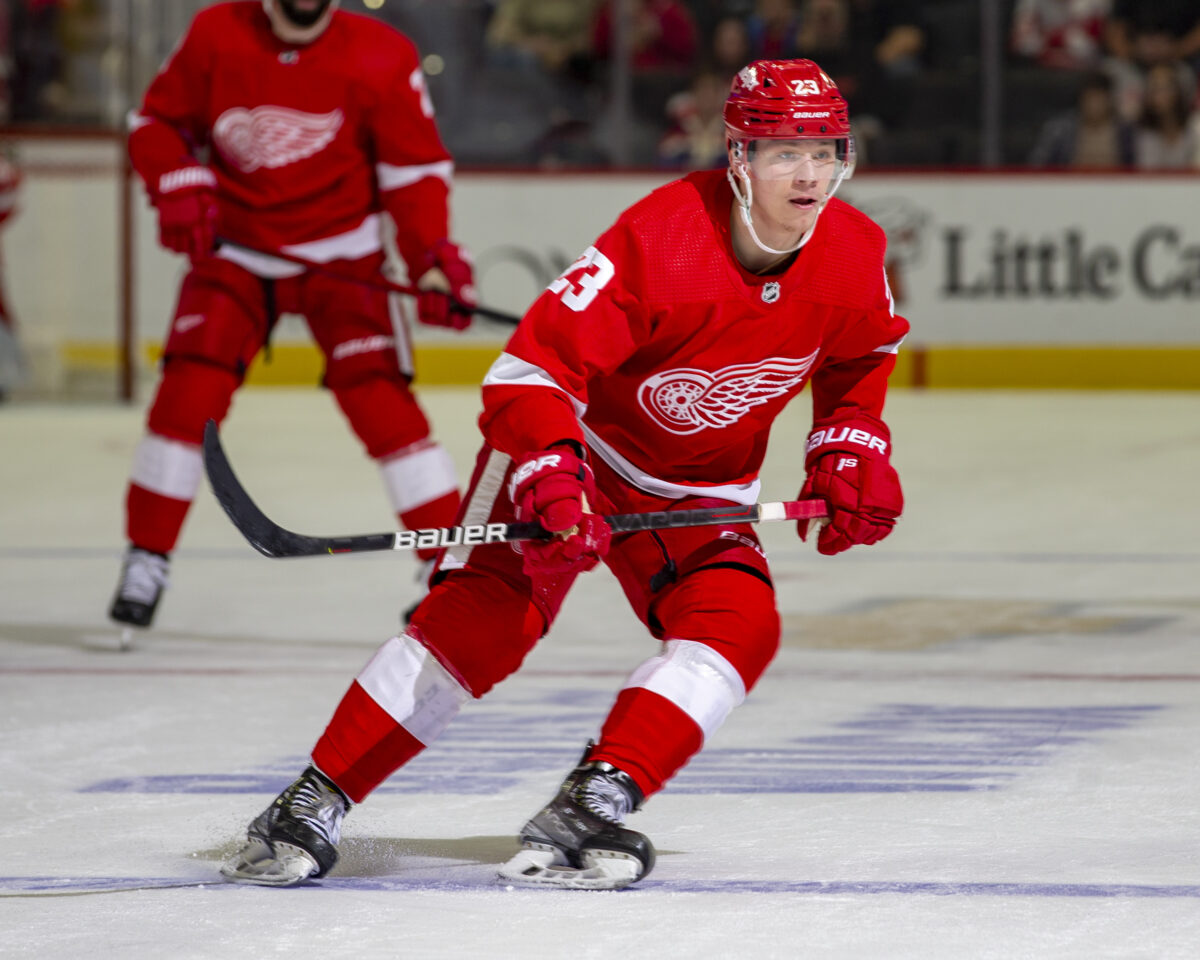To start the 2021-22 season, the Detroit Red Wings’ top line – consisting of captain Dylan Larkin, Tyler Bertuzzi and Lucas Raymond – has been more than good. In fact, they’ve even been more than great. Dare I say it….
They’ve been scratching the surface of perfection.
Throwing around a word like perfection can be a bit reckless. Even the best lines across the NHL have their flaws and experience bad games. Those same lines usually have a foundation of familiarity built between the three players. While it may seem like the Red Wings’ top trio have been playing together for years, they were only united at the start of this season. You know the drill here: small sample size, yadda yadda….
Another reason why it’s somewhat reckless to throw around the word perfection is because there’s already a line that exists in the NHL that is known as the “Perfection Line.” That would be the Boston Bruins’ top line, consisting of captain Patrice Bergeron, Brad Marchand and David Pastrnak. Together, that group regularly dominates in terms of possession and were a key reason why the Bruins were the Eastern Conference representative in the 2019 Stanley Cup Final. Sure enough, they’ve started this season off with that same level of dominance that Bruins fans have grown very familiar with.
Related: Bruins Need to Stop Playing Losing Hockey & Find Consistency
And yet, take a look what other lines have dominated to start this season:
Maybe it’s too early to say something this bold, but the early returns suggest that the Red Wings are building a “Perfection Line” of their own.
It All Stems From Lucas Raymond
Going back to the 2019-20 season, the Red Wings had one line that was able to post positive possession numbers, as well as a positive expected goals-for rate. That line consisted of Larkin, Bertuzzi and Anthony Mantha. That trio’s chemistry was evident whenever they were on the ice together, but even though they outscored their opponents 20-15 at even-strength despite playing on the worst team in the NHL that season, they weren’t able to reach the level and recognition reserved for the very best lines in the league.
You’ll notice that this year’s top line features two of the same players from that line: Larkin and Bertuzzi. The difference is that instead of a 25-year-old Mantha on the other wing, a 19-year-old rookie is riding shotgun with two of the Red Wings’ top offensive players, and that has made all the difference.

“He’s smart (and) brings a lot of energy,” Bertuzzi said of Raymond. “He’s just a good player. He’s fast and very smart.”
“We know the caliber of player he is (because of) what he did to get drafted so high,” Larkin said of the fourth pick in the 2020 draft. “Now through six games…what he’s done is impressive, and what I like most about him is his attitude.”
“He doesn’t seem like a 19-year-old to me. He’s mature beyond his years. He plays the right way and he gets rewarded for it.”
Indeed, Raymond’s impact on the Red Wings’ offense can be measured and observed in a number of ways. The eye test shows a young player that always seems to make the right decision in the offensive zone, and is just as good at creating turnovers in the neutral zone. The numbers only elevate the argument that this is a very special player. Per Natural Stat Trick, he has a Corsi-For percentage (CF%) of 55.6% through 82 minutes at even strength. His expected goals-for percentage (xGF%) in that same amount of time: 63.9%. To put that into perspective, Mantha led the Red Wings in 2019-20 with a CF% of 53.6% and a xGF% of 54.5%.
With the addition of Raymond alongside Larkin and Bertuzzi, the Red Wings have added a young player that looks capable of scoring upwards of 30 goals right off the hop to a duo that both play a complimentary style.
The Bruins Comparison
Both teams’ top lines consist of an offensive winger with the ability to create and convert, another winger with a blend of snarl and skill, and a two-way center – and both of those guys also happen to be their respective team’s captain.
In Raymond, the Red Wings have a player that can score and create offense with relative ease, much like what the Bruins have in Pastrnak. Since arriving in Boston, Pastrnak has averaged 37.7 goals and 80.4 points a season. Based on a (admittedly small) seven game sample to start this season, Raymond is on pace to score 46.7 goals and 93.5 points. Factoring in some regression, the Red Wings’ rookie winger looks poised to come in around Pastrnak’s breakout season in 2016-17 where he collected 34 goals and 70 points through 75 games.

Bertuzzi is snarly forward that isn’t afraid to muck it up and get under his opponent’s skin – a description that also fits Bruins winger Marchand, one of the more infamous players in the NHL. While Bertuzzi has never licked a player on the cheek, you’ll find often find him in the middle of it when things get heated out on the ice during a Red Wings game. With a career points per-game (P/G) rate of .63 through 214 career games, “Bert” also has the skill to punish his opponents when he goads them into taking a penalty. However, Marchand is in the next tier of this type of player. He has a career P/G rate of .89 through 809 career regular season games. Still, the sandpaper provided by both Marchand and Bertuzzi allow their linemates to do their thing in the offensive zone.
Related: Red Wings Tyler Bertuzzi’s Return Provides Immediate Spark
And then there’s Larkin, the Red Wings’ leader and a two-way center capable of pushing play in the right direction despite facing the toughest assignments, much like what the Bruins have in Bergeron, one of the most respected leaders and two-way forwards in the game. Larkin actually leads the Red Wings this season a CF% of 56.4, and a xGF% of just a hair under 65.
“Ultimately, I see Dylan Larkin as an outstanding two-way player,” Red Wings general manager Steve Yzerman said of his 25-year-old captain. “I don’t think we need him to lead the league in scoring. Whatever the goal totals turn out to be, they’ll be good enough for me. My goal for him, and him and I have talked about it, is to strive to be one of the best two-way players in the game.”
To his credit, Bergeron has won the Selke Trophy (awarded to the league’s top defensive forward) four times over his 18-year career so far. While Larkin can only dream of boasting that kind of resume at this point in his young career, it likely goes without saying that Bergeron is the exact player that the Red Wings’ coaches and management want him to model himself after.

While the level of skill and effectiveness may vary between the two teams, the formulas remain very similar to each other. It’s a cliché, but the NHL is a copycat league, and the Red Wings find themselves early on with a line that has instantly boosted their credibility around the league because it mirrors another line that has dominated the NHL since before the turn of the decade.
Red Wings are Still Building
Now before this rocketship takes off, let’s take stock of things.
The numbers don’t lie. The Bruins’ top unit has been more effective to start this season, and that’s not even to mention their accomplishments as a trio over the last few seasons. To compare the Red Wings’ top line to Boston’s is blowing things out of proportion, especially given the small sample size we’re dealing with on Detroit’s side of things. However, the results speak for themselves, and you have to wonder if/when they slow down, would they find a way to still be effective?
The average age of the Bruins’ trio is 31.3. The average of the Red Wings’ is 23.3. While the Red Wings’ group may not be at the heights that the Bruins’ group has reached, there’s plenty of upside there, and they may only get better as they grow more familiar with each other’s tendencies.
They say that it’s impossible to be perfect. In the case of the Red Wings’ top line, though, it seems that perfection is not out of the question.
